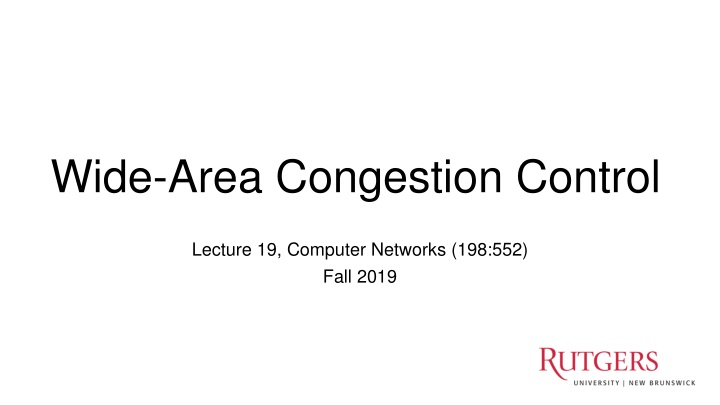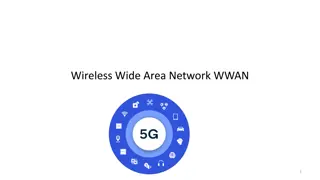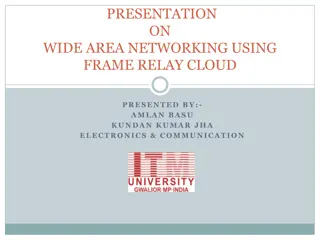
Wide-Area Congestion Control in Computer Networks
Explore the mechanisms of TCP congestion control, queue dynamics, sender behavior, and network models in managing congestion in computer networks. Learn about router buffer sizing implications and best practices for optimizing network performance.
Download Presentation

Please find below an Image/Link to download the presentation.
The content on the website is provided AS IS for your information and personal use only. It may not be sold, licensed, or shared on other websites without obtaining consent from the author. If you encounter any issues during the download, it is possible that the publisher has removed the file from their server.
You are allowed to download the files provided on this website for personal or commercial use, subject to the condition that they are used lawfully. All files are the property of their respective owners.
The content on the website is provided AS IS for your information and personal use only. It may not be sold, licensed, or shared on other websites without obtaining consent from the author.
E N D
Presentation Transcript
Wide-Area Congestion Control Lecture 19, Computer Networks (198:552) Fall 2019
Review: TCP congestion control Keep some in-flight (un-ACK ed) packets: congestion window Adjust window based on several algorithms: Startup: slow start Steady state: AIMD Loss: fast retransmission, fast recovery Window versus rate-based protocols
Queue Dynamics with TCP Steady-state behavior
Network model Propagation delay RTprop Queuing delay Link rate C Bottleneck queue (max size B) Single flow Packet-switched core network
Sender behavior at steady state Congestion avoidance: Additive increase, multiplicative decrease (AIMD) Steady state isn t static: lose pkts, grow cwnd, lose pkts, Loss Congestion Window halved time
Sender behavior at steady state How does the queue size at the bottleneck look, over time? Case 1: B = C * RTprop Case 2: B > C * RTprop Case 3: B < C * RT_prop Loss Congestion Window halved time
Network model Propagation delay RTprop Queuing delay Link rate C Bottleneck queue (max size B) Packet-switched core network Q: how does queue size look now? A few flows (say 3 4)
Network model Propagation delay RTprop Queuing delay Link rate C Bottleneck queue (max size B) Packet-switched core network Q: how does queue size look now? Many flows (say hundreds)
How big should router buffers be? Classic buffer-sizing rule: B = C * RTprop BDP buffer Single TCP flow halving its window still gets a throughput of 100% link rate Q: should buffers be BDP-sized? Significant implications: Massive pkt buffers (e.g., 40 Gbit/s with 200ms RTprop): high cost Massive pkt delays: bufferbloat
Key ideas Propagation delay RTprop Queuing delay Link rate C Bottleneck queue (max size B) Single flow 1. Estimate the bottleneck link rate C 2. Estimate the propagation delay RTprop 3. Send at rate C with at most k * C * RTprop packets in flight Pros and Cons?
(1) Estimating the bottleneck link rate Data can t be delivered to a receiver faster than the bottleneck link rate Measure the data delivery rate And use the maximum value over the recent past Important: measurements time out after a certain period Occasionally send higher (PROBE_BW cycling) to see if changed Q: how would you measure delivery rate at the receiver? Q: how would you measure delivery rate at the sender?
Measuring delivery rate at the sender Data that is unACKed at the time of transmitting packet Normal case: All that data (and only that data) is ACKed by this point unACKed data at pkt transmit time Round trip time between pkt-ACK
Quirk: Often, ACKs are aggregated More data appears to be in flight than there actually is Idea: use minimum of sent rate and received rate Q: how would you measure the rate at which data was sent? (Note: packets of received data and sent data must be the same)
(2) Estimating RTprop Use the minimum of the RTT values experienced so far If you re sending at high rate, it is difficult to see the true RTprop of the path Q: why? Occasionally send just a few packets in an RTT to measure RTprop (PROBE_RTT cycling) Also allows achieving fairness among BBR flows
The Internet: Many things to consider Bufferbloat Token-bucket policers Cellular base station scheduling Sometimes compete with few streams, sometimes many Delayed and aggregated ACKs (WiFi) Coexisting with legacy protocols (e.g., Cubic)









